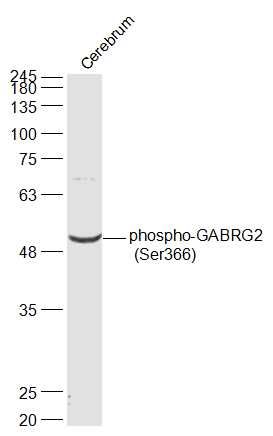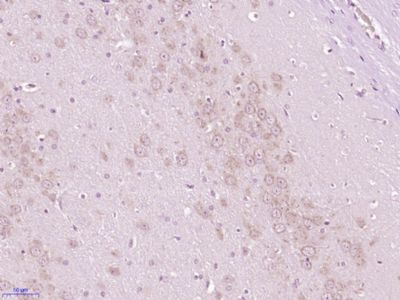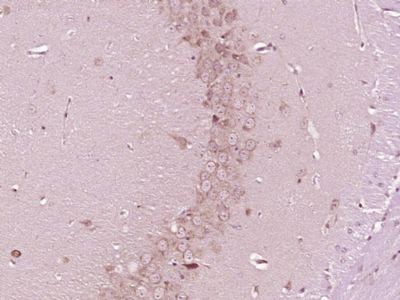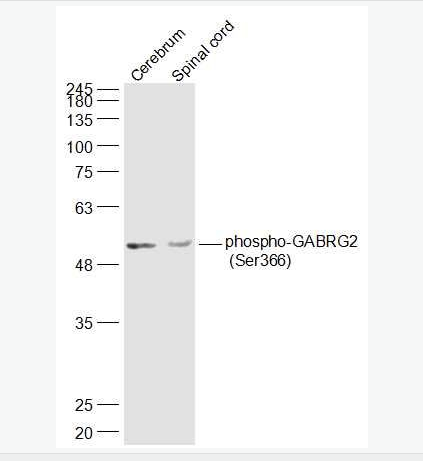| 中文名稱(chēng) | 磷酸化γ氨基丁酸γ2受體抗體 |
| 別 名 | p-GABAA Rγ2 (Ser 365); CAE 2; CAE2; ECA 2; ECA2; GABA(A) receptor subunit gamma 2; GABA(A) receptor subunit gamma-2; GABRG 2; GABRG2 antibody Gamma aminobutyric acid (GABA) A receptor gamma 2; Gamma aminobutyric acid A receptor gamma 2; Gamma aminobutyric acid receptor gamma 2 subunit; Gamma-aminobutyric acid receptor subunit gamma-2; Gamma-aminobutyric-acid receptor gamma-2 subunit; GBRG2_HUMAN; GEFSP 3; GEFSP3. |
| 產(chǎn)品類(lèi)型 | 磷酸化抗體 |
| 研究領(lǐng)域 | 神經(jīng)生物學(xué) 通道蛋白 細(xì)胞膜受體 G蛋白偶聯(lián)受體 G蛋白信號(hào) |
| 抗體來(lái)源 | Rabbit |
| 克隆類(lèi)型 | Polyclonal |
| 交叉反應(yīng) | Mouse, Rat, (predicted: Human, Chicken, Dog, Pig, Cow, Horse, Sheep, ) |
| 產(chǎn)品應(yīng)用 | WB=1:500-2000 ELISA=1:500-1000 IHC-P=1:100-500 IHC-F=1:100-500 ICC=1:100-500 IF=1:100-500 (石蠟切片需做抗原修復(fù)) not yet tested in other applications. optimal dilutions/concentrations should be determined by the end user. |
| 分 子 量 | 50kDa |
| 細(xì)胞定位 | 細(xì)胞膜 |
| 性 狀 | Liquid |
| 濃 度 | 1mg/ml |
| 免 疫 原 | KLH conjugated synthesised phosphopeptide derived from human GABRG2 around the phosphorylation site of Ser366:KP(p-S)KD |
| 亞 型 | IgG |
| 純化方法 | affinity purified by Protein A |
| 儲(chǔ) 存 液 | 0.01M TBS(pH7.4) with 1% BSA, 0.03% Proclin300 and 50% Glycerol. |
| 保存條件 | Shipped at 4℃. Store at -20 °C for one year. Avoid repeated freeze/thaw cycles. |
| PubMed | PubMed |
| 產(chǎn)品介紹 | GAD-65 and GAD-67, glutamate decarboxylases, function to catalyze the production of GABA (gamma-aminobutyric acid). In the central nervous system, GABA functions as the main inhibitory transmitter by increasing a Cl- (chloride) conductance that inhibits neuronal firing. GABA has been shown to activate both ionotropic (GABAA) and metabotropic (GABAB) receptors, as well as a third class of receptors called GABAC. The ?subunit of GABAA receptors are important for benzodiazepine binding and modulation of GABA-mediated Cl- current. GABAA R? is a 467 amino acid mulit-pass membrane protein localized to the postsynaptic cell membrane. Present as a pentamer with other GABAA receptor chains (Alpha, Beta, Gamma, Delta and Epsilon), the GABAA ligand-gated Cl- channels selectively complex with D5DR to enable mutual inhibitory functional interactions between the two receptor systems. Defects in the gene encoding GABAA R Gamma 2 have been found to be the cause of childhood absence epilepsy type 2, familial febrile convulsions type 8, generalized epilepsy with febrile seizures plus type 3 and severe myoclonic epilepsy in infancy. Function: GABA, the major inhibitory neurotransmitter in the vertebrate brain, mediates neuronal inhibition by binding to the GABA/benzodiazepine receptor and opening an integral chloride channel. Subunit: Generally pentameric. There are five types of GABA(A) receptor chains: alpha, beta, gamma, delta, and rho. Interacts with GABARAP. Subcellular Location: Cell junction, synapse, postsynaptic cell membrane; Multi-pass membrane protein. Cell membrane; Multi-pass membrane protein. Post-translational modifications: Palmitoylated by ZDHHC3/GODZ; which may affect presynaptic clustering and/or cell surface stability. DISEASE: Defects in GABRG2 are the cause of childhood absence epilepsy type 2 (ECA2) [MIM:607681]. ECA2 is a subtype of idiopathic generalized epilepsy (IGE) characterized by an onset at age 6-7 years, frequent absence seizures (several per day) and bilateral, synchronous, symmetric 3-Hz spike waves on EEG. During adolescence, tonic-clonic and myoclonic seizures develop. Some individuals manifest ECA2 occurring in combination with febrile convulsions. Defects in GABRG2 are the cause of familial febrile convulsions type 8 (FEB8) [MIM:611277]. A febrile convulsion is defined as a seizure event in infancy or childhood, usually occurring between 6 months and 6 years of age, associated with fever but without any evidence of intracranial infection or defined pathologic or traumatic cause. Febrile convulsions affect 5-12% of infants and children up to 6 years of age. There is epidemiological evidence that febrile seizures are associated with subsequent afebrile and unprovoked seizures in 2% to 7% of patients. Defects in GABRG2 are the cause of generalized epilepsy with febrile seizures plus type 3 (GEFS+3) [MIM:604233]. Generalized epilepsy with febrile seizures-plus refers to a rare autosomal dominant, familial condition with incomplete penetrance and large intrafamilial variability. Patients display febrile seizures persisting sometimes beyond the age of 6 years and/or a variety of afebrile seizure types. GEFS+ is a disease combining febrile seizures, generalized seizures often precipitated by fever at age 6 years or more, and partial seizures, with a variable degree of severity. Defects in GABRG2 are a cause of severe myoclonic epilepsy in infancy (SMEI) [MIM:607208]; also called Dravet syndrome. SMEI is a rare disorder characterized by generalized tonic, clonic, and tonic-clonic seizures that are initially induced by fever and begin during the first year of life. Later, patients also manifest other seizure types, including absence, myoclonic, and simple and complex partial seizures. Psychomotor development delay is observed around the second year of life. SMEI is considered to be the most severe phenotype within the spectrum of generalized epilepsies with febrile seizures-plus. Similarity: Belongs to the ligand-gated ion channel (TC 1.A.9) family. Gamma-aminobutyric acid receptor (TC 1.A.9.5) subfamily. GABRG2 sub-subfamily. SWISS: P18507 Gene ID: 2566 Database links: Entrez Gene: 282240 Cow Entrez Gene: 2566 Human Entrez Gene: 14406 Mouse Entrez Gene: 29709 Rat Omim: 137164 Human SwissProt: P22300 Cow SwissProt: P18507 Human SwissProt: P22723 Mouse SwissProt: P18508 Rat Unigene: 7195 Human Unigene: 5309 Mouse Unigene: 159942 Rat Important Note: This product as supplied is intended for research use only, not for use in human, therapeutic or diagnostic applications. |
| 產(chǎn)品圖片 |  Sample: Sample:Cerebrum (Rat) Lysate at 40 ug Spinal cord (Mouse) Lysate at 40 ug Primary: Anti-phospho-GABRG2 (Ser366) (bs-12079R) at 1/1000 dilution Secondary: IRDye800CW Goat Anti-Rabbit IgG at 1/20000 dilution Predicted band size: 50 kD Observed band size: 50 kD  Sample: Sample:Cerebrum (Mouse) Lysate at 40 ug Primary: Anti-phospho-GABRG2 (Ser366) (bs-12079R) at 1/1000 dilution Secondary: IRDye800CW Goat Anti-Rabbit IgG at 1/20000 dilution Predicted band size: 50 kD Observed band size: 50 kD  Paraformaldehyde-fixed, paraffin embedded (Rat brain); Antigen retrieval by boiling in sodium citrate buffer (pH6.0) for 15min; Block endogenous peroxidase by 3% hydrogen peroxide for 20 minutes; Blocking buffer (normal goat serum) at 37°C for 30min; Antibody incubation with (phospho-GABRG2 (Ser366)) Polyclonal Antibody, Unconjugated (bs-12079R) at 1:400 overnight at 4°C, followed by operating according to SP Kit(Rabbit) (sp-0023) instructionsand DAB staining. Paraformaldehyde-fixed, paraffin embedded (Rat brain); Antigen retrieval by boiling in sodium citrate buffer (pH6.0) for 15min; Block endogenous peroxidase by 3% hydrogen peroxide for 20 minutes; Blocking buffer (normal goat serum) at 37°C for 30min; Antibody incubation with (phospho-GABRG2 (Ser366)) Polyclonal Antibody, Unconjugated (bs-12079R) at 1:400 overnight at 4°C, followed by operating according to SP Kit(Rabbit) (sp-0023) instructionsand DAB staining. Paraformaldehyde-fixed, paraffin embedded (Mouse brain); Antigen retrieval by boiling in sodium citrate buffer (pH6.0) for 15min; Block endogenous peroxidase by 3% hydrogen peroxide for 20 minutes; Blocking buffer (normal goat serum) at 37°C for 30min; Antibody incubation with (phospho-GABRG2 (Ser366)) Polyclonal Antibody, Unconjugated (bs-12079R) at 1:400 overnight at 4°C, followed by operating according to SP Kit(Rabbit) (sp-0023) instructionsand DAB staining. Paraformaldehyde-fixed, paraffin embedded (Mouse brain); Antigen retrieval by boiling in sodium citrate buffer (pH6.0) for 15min; Block endogenous peroxidase by 3% hydrogen peroxide for 20 minutes; Blocking buffer (normal goat serum) at 37°C for 30min; Antibody incubation with (phospho-GABRG2 (Ser366)) Polyclonal Antibody, Unconjugated (bs-12079R) at 1:400 overnight at 4°C, followed by operating according to SP Kit(Rabbit) (sp-0023) instructionsand DAB staining. |
我要詢(xún)價(jià)
*聯(lián)系方式:
(可以是QQ、MSN、電子郵箱、電話(huà)等,您的聯(lián)系方式不會(huì)被公開(kāi))
*內(nèi)容:









